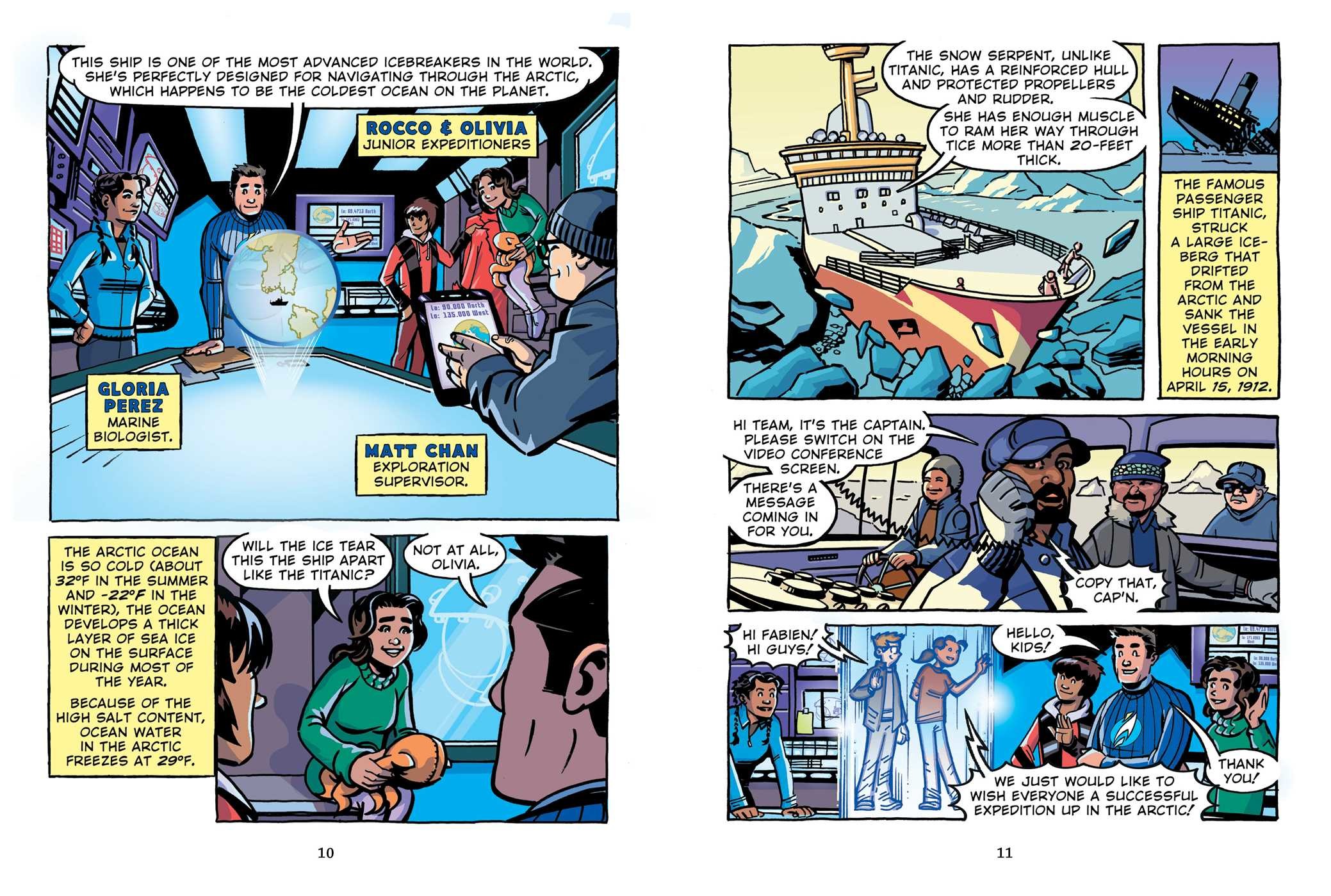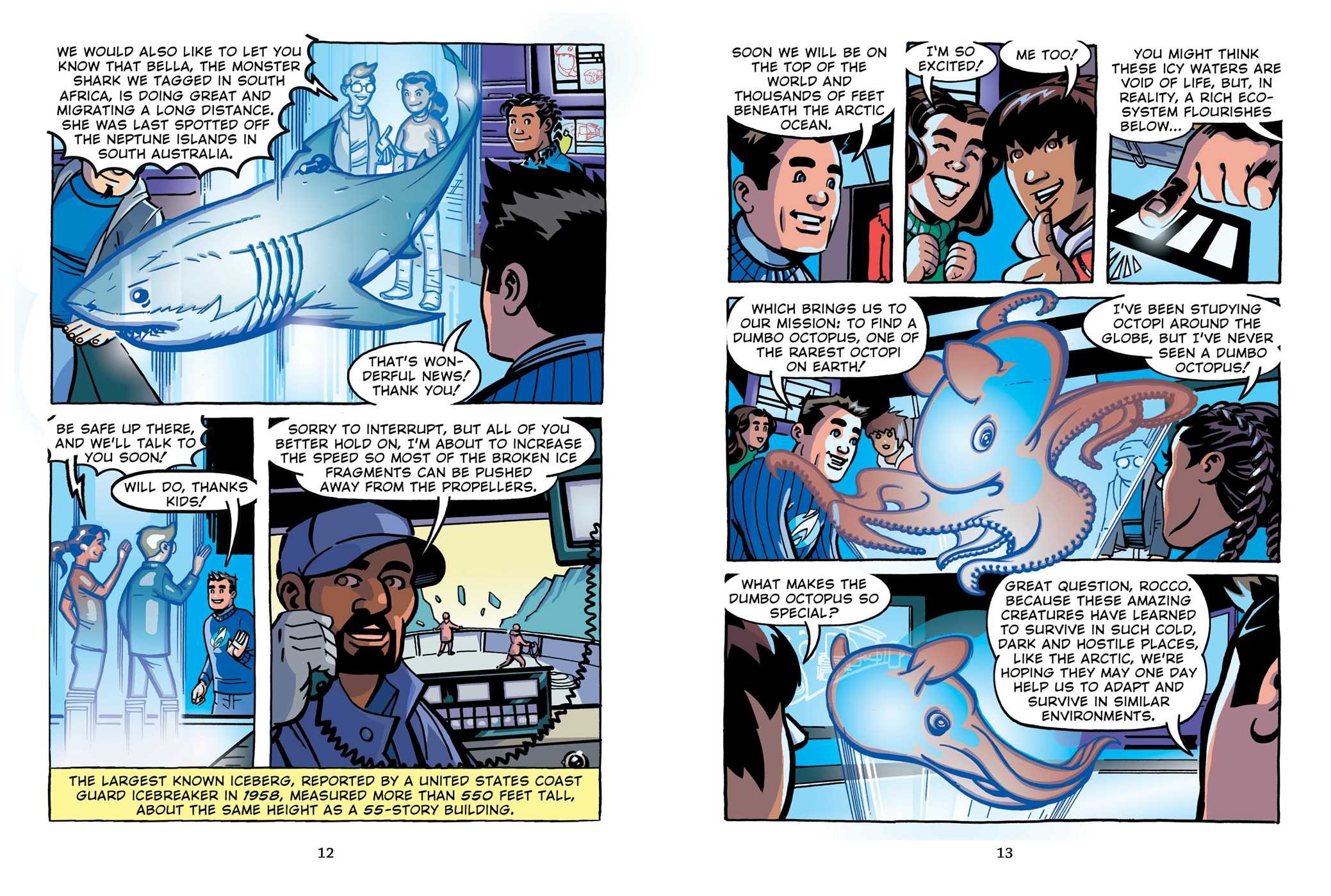Plus, receive recommendations and exclusive offers on all of your favorite books and authors from Simon & Schuster.
Journey under the Arctic
Table of Contents
About The Book
Junior explorers Rocco and Olivia embark on an exciting journey into the frigid Arctic waters with famed explorer Fabien Cousteau and his research team. Together, they hope to find the rare dumbo octopus and uncover how this exceptional creature is able to live in such an extreme climate. To get there, they’ll board an icebreaker to travel to the Arctic Circle, and will come face to face with polar bears, puffins, Artic hares, and more. Then they’ll climb into a submersible and dive deep under the surface to see whales, narwhals, and other incredible species only found in these mysterious depths.
Join the team on this deep-sea expedition, and learn how the changing climate affects the ocean and its inhabitants, and discover what you can do to help save the planet!
Reading Group Guide
Get a FREE ebook by joining our mailing list today! Plus, receive recommendations for your next Book Club read.
Fabien Cousteau Expeditions: Great White Shark Adventure
Fabien Cousteau Expeditions: Journey Under the Arctic
By Fabien Cousteau and James O. Fraioli
Illustrated by Joe St.Pierre
About the Books
Great White Shark Adventure and Journey Under the Arctic feature Fabien Cousteau, grandson of the renowned explorer Jacques Cousteau, along with expedition scientists and two junior explorers. On these expeditions, Fabien and his crew search for a huge great white shark to tag, and the reclusive Dumbo octopus to study. The purpose of these missions is to learn more about each species as well as bring awareness to a changing climate and its impact on sea life. In each book, a pair of junior explorers has the opportunity to learn more about these animals while participating in the expeditions, which turn out to be full of great adventures.
Discussion Questions
1. Discuss why you think ship statistics and information are included in both books. How does knowing this information help in the exploration? What things might you need to think about or plan for before embarking on expeditions of these sizes?
2. What part does weather play in Cousteau’s expeditions? Explain why weather knowledge is important when on the ocean.
3. Describe three or four of the ecosystems explored in the books. What life was in each? What most surprised you? Which would you prefer to explore further? Explain your answers.
4. Describe and explain the purpose of baleen, and how it works to get food for the whale.
5. What part do krill play in ocean food webs? What could affect the krill population, and what impact would it have on the larger food web? Can you think of any other organisms that are vital to other food webs?
6. Identify some of the ways that marine animals have adapted to different environments, and explain how each adaptation helps that species to survive. Have you observed any of these occurances in your own communities or travels?
7. In what ways can individuals reduce their impact on the environment and cut down on the carbon dioxide put into the atmosphere? Why is this important?
8. Give some examples from the books that indicate instinctual behaviors, as well as learned behaviors. How can you tell the difference? Do you think one is more impactful than the other? Explain your answers.
9. In what ways are the ecosystems described in both books changing due to a warming climate? What impact will it have on humans and organisms?
10. What effects do humans have on the environments in these books? How does that make you feel? Does it make you more conscious of your behaviors and those of the people around you? Explain your answers.
11. Explain your reasoning for or against going into a shark cage. What are the benefits? What are the dangers?
12. In what ways is technology used to study sharks and their environments? What kind of information is collected?
13. How can the destruction of one species affect an entire ecosystem? Think about the depleted shark population on the stingrays and scallops. How does having sharks in the ocean improve the ecosystem? Can ecosystems adapt in the same way individual animals do?
14. Why does Shark Alley attract so many great white sharks?
15. Why is it necessary for sharks to keep moving in the water? What will occur if they stop swimming?
16. Define the word ballast. Why is ballast necessary, and how was it used in Journey Under the Arctic?
17. Describe the benthic zone and some of the life found there. How have organisms there adapted to living so deep in the darkness?
18. What kind of gear is needed to explore the Arctic Ocean? Why is it necessary?
19. Discuss the consequences for a narwhal if it loses its tusk. What else do you know about narwhals, and what more would you like to learn?
20. What role do copepods and other zooplankton play in the food web? What will happen if their numbers are reduced?
21. Why did the team in the submersible leave the site where the polar bears were attempting to feed?
22. How is the food web affected by melting polar ice? What are the ultimate consequences for animal life and humans?
Extension Activities
Father of Scuba Diving
Jacques Cousteau is known as the father of Scuba diving. SCUBA stands for self-contained underwater breathing apparatus. Research the history of diving and the contributions made by Jacques Cousteau and others. Present the information in a multimedia format.
Super Armor
Describe shark skin. What is special about it, and how is it arranged? Research ways scientists are looking to use shark skin to improve people’s lives, and share your most interesting or surprising finding with your classmates.
To Dive or Not to Dive
Research arguments for and against shark-cage diving. With your classmates, present the information in a debate format. Alternatively, you can choose a side and write about it in a persuasive essay.
Snowshoe Stories
Research the physics of snowshoes, and write a description of how they work. Then partner with your classmates to design an experiment demonstrating their effectiveness.
Build a Model Snow House
Using the description from Journey Under the Arctic, create a model of a snow house using sugar cubes. Identify any difficulties you have, and how that would translate into building an actual snow house in the Arctic.
Whale Tales
Choose five different species of whales. Then develop and create a chart that compares and contrasts their characteristics. Present your chart to your classmates, and using information you learned in these books about ecosystems and adaptations, discuss why different species might have different features.
Shark Swimsuits
Research shark-inspired technology used on swimsuits by swimmers racing in the Olympics. What resulted from wearing these suits, and why were they banned?
Make It Graphic!
Choose a food chain from an ecosystem described in these books. Explain the process in more detail using a graphic novel format that includes word bubbles and images.
Lexile Level, Great White Shark Adventure: Lexile ® GN890L
F&P Level, Great White Shark Adventure: Fountas & Pinnell™ V
Lexile Level, Journey Under the Arctic: Lexile ® GN800L
This curriculum guide was prepared by Shirley Duke. She is a former science teacher and author of many science books for children and a freelance science writer.
This guide has been provided by Simon & Schuster for classroom, library, and reading group use. It may be reproduced in its entirety or excerpted for these purposes. For more Simon & Schuster guides and classroom materials, please visit simonandschuster.net or simonandschuster.net/thebookpantry.
The Lexile reading levels have been certified by the Lexile developer, MetaMetrics®.
Great White Shark Adventure has been officially leveled by using the F&P Text Level Gradient™ Leveling System.
About The Illustrator
Joe St.Pierre has illustrated for Marvel and DC Comics, and works in the fields of intellectual property design, commercial illustration, and storyboards for animation and video games. Clients have included MTV, Discovery Channel, Nickelodeon, Warner Bros. Animation, Cartoon Network, The New York Times, The Wall Street Journal, and PBS. Joe’s publishing company, Astronaut Ink, highlights his creator-owned properties. See his work at AstronautInk.com.
Product Details
- Publisher: Margaret K. McElderry Books (March 17, 2020)
- Length: 112 pages
- ISBN13: 9781534420908
- Grades: 3 - 7
- Ages: 8 - 12
- Lexile ® GN800L The Lexile reading levels have been certified by the Lexile developer, MetaMetrics®
Browse Related Books
Raves and Reviews
"Illustrations are bold and colorful with sharp outlines helping to keep the focus on the action, animals, and discoveries. A welcome addition to the growing number of nonfiction, science-focused graphic novels."
– Booklist
Awards and Honors
- Kansas NEA Reading Circle List Intermediate Title
- CBC/NSTA Outstanding Science Trade Book
Resources and Downloads
High Resolution Images
- Book Cover Image (jpg): Journey under the Arctic Paper Over Board 9781534420908
- Author Photo (jpg): Fabien Cousteau Photograph by Carrie Vonderhaar(0.1 MB)
Any use of an author photo must include its respective photo credit
- Author Photo (jpg): James O. Fraioli Mary Dee Mateo Photography(0.1 MB)
Any use of an author photo must include its respective photo credit
























